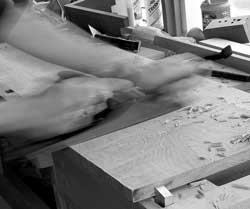
This week I’m deep into reading Joseph Moxon’s “Mechnick Exercises” – the first English-language treatise on the craft of joinery. Published in 1678, the “Exercises” cataloged the tools and practices of the blacksmith, joiner, house carpenter, turner, bricklayer and those who make sundials.
For the modern reader, the book can be a horrible slog. The printed English word of the 17th century seems convoluted. Sentences run on for far longer than we are accustomed to, and the sentences are interrupted by asides that wander a bit. Then they’ll insert a reminder of the original point of the sentence and swoop in on the end of the phrase.
Truth be told, you get used to it after a few pages. Then the hardest thing becomes the occasional unfamiliar word – for example, “dawks” means “hollows” – and the odd tool. My favorite example: the pricker. The pricker is a marking tool that perhaps resembles a square-shanked awl. But in Moxon’s glossary he says the vulgar term is “awl” and instead the proper word is “pricker.”
So as of today, the filthy word “awl” has been banished from our shop in favor of the much more polite “pricker.”
Every time I read Moxon I learn something interesting and useful. But what is most fascinating is how little has changed in 330 years. The tools and the methods are familiar – once you strip away the “shall yets.” Except for one important difference.
What strikes me during this reading of Moxon is his affection for the fore plane – a tool that is typically 16” long, which is shorter than jointer plane and longer than a jack plane. The fore plane has a blade with an obvious curve and is used to quickly remove material.
Moxon spills more ink on the fore plane and its use than he does on any other single plane. He discusses how it is used with its iron set both rank and fine. How it is moved across the board. How it trues faces and edges. The jointer plane gets some discussion, but not nearly as much as the fore.
And then there’s the discussion of the smoothing plane. Here is the entire entry on the smoothing plane (cleaned up a tad):
“The smoothing plane marked B 4. must have its iron set very fine, because its office is to smooth the work from those irregularities the fore plane made.”
That’s really about it. There’s no protracted discussion of the smoother and wispy shavings or strategies to reduce tear-out (though Moxon suggests that high planing angles are important in one part of the book).
Our obsession with smoothing planes might be thoroughly modern. Or perhaps there’s another way to look at this (bear with me, I know this is getting long).
Recently we had Matt Grisley from Leigh Industries in our shop to demonstrate his company’s new dovetail jigs. During our day together, he made an astute observation about hand work. I wrote it down after he said it. And it went something like this:
“What’s interesting to me is how woodworkers who love hand tools also love the heavy machinery – the big planers, jointers and table saws. And they don’t seem to have much affection for the power hand tools, like the router and biscuit joiner.”
And he’s right. I am deeply indebted to my planer and jointer. I would get rid of five of my smoothing planes before I got rid of my jointer and planer (don’t worry I’d still have at least five smoothers left).
I am obsessed with my heavy machinery like Moxon’s workmen were attached to their fore planes. For these are the tools that get the brute work done, that make woodworking possible. The finesse work stands on the shoulders of the fore plane and machinery. Now if you’ll excuse me I’m off to the shop to fiddle with my square, saw and pricker.
— Christopher Schwarz